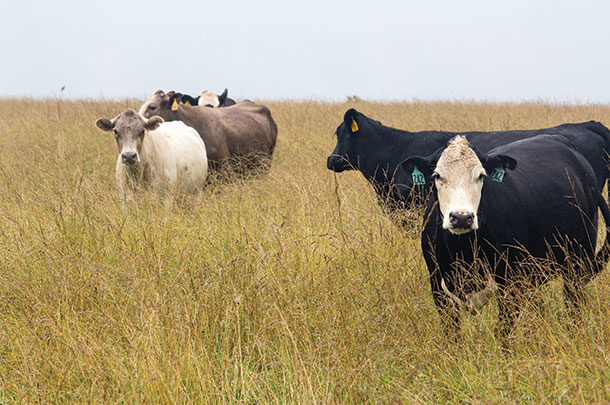Tall fescue is the main forage species supporting the large beef cow-calf industry in Missouri and other states.
Unfortunately, many fields of tall fescue are infected with an endophytic fungus that produces compounds toxic to many species of livestock. These toxic compounds cause a variety of health and production issues, some of which can be life-threatening.
In response to these production and health issues, plant breeders have spent decades working on ways to overcome the toxic effects of endophyte-infected tall fescue.
Initially, plant breeders removed the endophyte from the grass. This eliminated the livestock issues but, unfortunately, also reduced the persistence of the grass.
Research continued, and strains of endophytic fungus were identified that did not produce chemicals toxic to livestock. These strains of fungus were inserted into endophyte-free tall fescue seed.
When this newly inoculated seed was grown out, the new tall fescue plants retained the persistence characteristics of endophyte-infected tall fescue without causing debilitating livestock issues.
Work continued to identify and merge strains of endophytic fungus into various genotypes of tall fescue germplasm. These new varieties were called “novel” or “non-toxic” tall fescue. Currently, there are approximately half-a-dozen novel endophyte tall fescue varieties commercially available in our state.
Replacing a field of toxic endophyte-infected (E+) tall fescue with another crop is not straightforward. In Missouri, the process requires spraying out the old tall fescue, planting a smother crop and spraying again before the new crop can be planted.
This process is known as the “spray-smother-spray” technique, and all three steps are important. The technique is designed to replace old tall fescue with another cool-season grass, not a warm-season crop.
Normally, a stand of grass can be killed with a high rate of glyphosate, which is sold under a variety of different trade names but is perhaps most commonly known as Roundup. With toxic tall fescue, however, killing the stand usually requires multiple applications of glyphosate. That is because a single spray may not kill all the individual plants.
Many tillers are covered by dung piles and escape herbicide contact, often re-emerging later in the year. Also, a single spray does not kill the tall fescue seed present in the soil. This seed, still infected with the old endophyte, can germinate and provide toxic seedlings long after the field is sprayed.
The “spray-smother-spray” technique is shown in Figure 1. There are different techniques proven to be effective in other states, and those may eventually be proven effective in Missouri.

But for now, the spray-smother-spray recipe is considered most reliable. The entire procedure can be done in four months and will provide excellent summer pasture in the process.
Fields being considered for renovation should be soil sampled in advance, and necessary soil amendments should be applied. Seedheads of the toxic fescue should be controlled the spring that the renovation process begins.
The initial spray is in late May – between May 15 and May 21 – which is about one week before a summer annual crop would be planted. Glyphosate should be applied at a rate of at least 2 pounds per acre, or 2 quarts per acre of a 4-pound-per-gallon glyphosate formulation. Because the initial spray does not kill all the infected tall fescue tillers, a tall smother crop is planted.
The smother crop not only crowds out escape tillers, it also forms a thick canopy over them which limits sunlight yet allows the tillers to grow and be ready for the second spray. From a production perspective, the smother crop provides forage while the perennial forage is out of production.
The smother crop is no-till planted on or near June 1, and it is usually pearl millet or a hybrid of sorghum x sudangrass. The smother crop is either grazed all summer or harvested for hay.
A second application of glyphosate is sprayed in late August – between August 15 and August 21 – about one week before the new cool-season grass is planted.
If the spray-smother-spray technique is followed and the new cool-season grass is well established, E+ tall fescue is not likely to reappear. Reappearance of E+ tall fescue sometimes occurs when the new grass is a warm-season species. Warm-season grasses do not form a canopy over the newly killed tillers.
Reappearance of E+ tall fescue can also occur when the newly established cool-season grass lacks persistence. The lack of persistence in perennials such as orchardgrass and perennial ryegrass can result in a thin stand, thereby allowing weeds to become established.
In cases where the new grass is likely to thin, interseeding a nonaggressive companion legume, such as birdsfoot trefoil, may be wise. The birdsfoot trefoil would grow into thinned areas, preventing exposed soil and providing a high-quality component to the new pasture. Yet because it has poor seedling vigor, it will not compete with the new grass.
Renovating stands of toxic tall fescue with new novel endophyte tall fescue varieties takes planning and management. However, once a novel endophyte tall fescue variety has been established, producers can rest easier knowing the animal toxicity issues they have been used to dealing with have been eliminated and that the new grass is likely to persist. ![]()
PHOTO: Cows in tall fescue. Photo by Lynn Jaynes
Craig Roberts is a professor of agronomy at the University of Missouri.
Gene Schmitz is a livestock specialist at the University of Missouri. Email Gene Schmitz.










